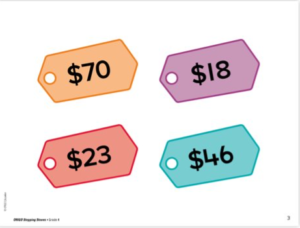Insights
Keep Calm and Differentiate Your Math Instruction
In the 2022–2023 school year, it strikes me that we need to work smarter not harder. We need to keep calm and carry on. I’ve always loved this sentiment. As we get back into our school routines after two years of interrupted teaching, it’s more important now than ever, that we concentrate on what we know works, make steady progress, and teach strategically to make sure that as many students as possible master grade-level mathematics content. One of the ways we can achieve this is to effectively differentiate instruction to the learners in our classes. In this post (and companion webinar), I share three differentiation strategies that I believe will help you meet your students where they are and keep them moving to where they need to be by the end of the year.
First, A Word About Differentiation
When I think about differentiation, I’m focused on the idea that we have students in a single class who are learning in different ways and at different times. How do we make small adjustments to help all students move forward? How do we reach the right level of challenge for every student? How do we make sure that all students are in the zone of proximal development, the learning zone, which is, of course, different for each child?
Strategy 1—Identify the Most Important Math Needs
We’ve always had a range of learners in our classes, although perhaps today an even wider range. Maybe we have more students who haven’t mastered all of the previous year’s mathematical content. So, we’re going to need to back up a bit and teach, reteach, or review key content. You’ll notice that I specified key content. I think there’s a perception that we have to double up over the next couple of years so that students can catch up. But research tells us that going faster isn’t the answer.
Rather we need to focus on the essential content from the previous year that helps students master current year content, or what I refer to as bridge content. For example, as students move from first to second grade they are expanding fluency from numbers up to 10 to numbers up to 20. They are focusing more on additive comparison where the language may not be as friendly. When students graduate from third to fourth grade, they move from comparing fractions to operating with fractions. They take what they know about addition and expand it to fractions. And remember, we don’t have to review all of the bridge content at once, but only as it pertains to the math instruction for the module we are currently working on.
Additionally, I would encourage you to identify the one mathematical concept your students needed to have mastered in the previous year to avoid having significant problems learning new content this year. When I taught sixth grade, I knew that if my students left with a strong sense of ratio and multiplicative reasoning vis-à-vis ratio, that they would do just fine in seventh grade. If kids leave second grade with a clear understanding of all the different jobs that addition and subtraction perform, they can confidently tackle the challenges of third-grade math.
So, when you are thinking about how best to help kids catch up, focus only at the content from the previous year that is most essential to learning current-year mathematical concepts, and only at the time students need it.
Strategy 2—Modify Existing Tasks
When I talk with teachers around the country about effective differentiation, sometimes I hear that they don’t have time to create new tasks or problems geared to all of the learning levels in their classrooms. To that, I say, “of course, you don’t!” Start with what you have, and make modifications. Maybe you go back to the end of the previous year and pull some tasks that highlight key bridge content, and make them a bit more challenging. Or take current tasks that may be a little too difficult, and make them a bit easier.
When you vary tasks to differentiate instruction, consider both difficulty and complexity. I used to think that these were similar, but in working with John Hattie on Visible Learning for mathematics, I’ve come to realize that they are distinctly different and that this difference has powerful implications for differentiated instruction. Difficulty is about whether the task or problem is easy or hard, are the numbers friendly, is the language simple. Complexity is about how many parts, steps, or layers does a task have. When we think about difficulty and complexity independently, it makes creating multiple variations of a single task relatively simple.
Let’s look at a fourth-grade task on doubling from Stepping Stones 2.0.
You are buying two of any item. What is the cost ?

Thinking about difficulty, we might change the prices to make them all multiples of five to make the task easier. To make the task more complex, we might ask the student to buy two of any two items and calculate the total cost. Or what if we were more strategic about one of the numbers we use and change the $23 price tag to $20. We know that double 20 is 40, so that might make it easier to double 18, which is two less than 20. If double 20 is 40, and 18 is two steps down from 20 and double 2 is 4, then take away four from 40 is 36. So double 18 is 36.
This may not be friendly reasoning for every child. What other strategies—building up or building down, partial sums and partial products, estimating and scaling—might help students think about the math in a different way. What tools—number lines, base-10 blocks, place value charts—might you introduce to help students make the task more concrete. Teaching alternate ways to approach the problem is another way to differentiate instruction using the same task.
The bottom line is that if you think a task is too easy or hard, keep the task because it saves you from having to design a completely separate one, but adapt the numbers to where your students are.
Strategy 3—Create Flexible Grouping
Despite our best intentions, we often create static groups in school, groups that a student is slotted into and stays in. This can lead to different tracks based on initial assessments that doom students in “lower” groups to lesser mathematics achievement. That’s a problem. It’s an equity issue. It’s a learning issue. So, how do we make sure we create flexible groups that provide students with differentiated instruction while also allowing all students to succeed?
To make sure you have flexible grouping, I want to encourage you to incorporate three types of grouping routines. In the lower grades, you might introduce these groups across an entire semester. In the upper grades, you might be able to introduce the groups more quickly.
The core group is the one you use for day-to-day instruction, perhaps organized by pushing desks together to make four to six big tables. These groups should be heterogeneous, which research shows is essential. This might mean grouping by skills, by gender, by language acquisition, or by other attributes. You may decide to keep these base groups for the entire year or you might change them, as I did when I taught sixth grade, every marking period, which for me meant four times per year.
The second grouping is random, just for a single day or a single activity. I like to form groups of three, since I think in larger groups, it may too easy for a student to hide. You can group randomly using any method you like. I use playing cards and separate out enough ranks to form groups of three. I put an Ace on one table, a King on another, a Queen on yet another, and so on. And then I shuffle the remaining reduced deck of cards and each student selects a card and goes to the table with the matching rank.
The third grouping is for deliberate, instructional groups. These are the students who may be working with the teacher during center time. It needs to be normal that all students work with the teacher at some time on different concepts. And we want to be careful about how we refer to these groups, we want to concentrate on what we are learning and not place a value (advanced or basic) on the learning.
The important thing to communicate is that students are taking different paths and moving at different speeds, but are all ending up in the same place.
A final word—be intentional, work strategically, keep kids moving forward, and do what we know helps them learn.




